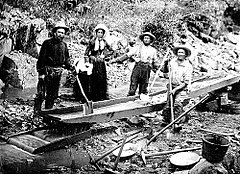The california gold rush

Prospectors working California gold placer deposits in 1850
|
|
| Date | January 24, 1848–1855 |
|---|---|
| Location | Sierra Nevada and Northern California goldfields |
| Coordinates | 38°48′09″N 120°53′41″W / 38.80250°N 120.89472°WCoordinates: 38°48′09″N 120°53′41″W / 38.80250°N 120.89472°W |
| Participants | 300,000 prospectors |
| Outcome | California becomes a U.S. state California Genocide |
The California Gold Rush (1848–1855) began on January 24, 1848, when gold was found by James W. Marshall at Sutter's Mill in Coloma, California. The news of gold brought some 300,000 people to California from the rest of the United States and abroad. The sudden influx of immigration and gold into the money supply reinvigorated the American economy, and California became one of the few American states to go directly to statehood without first being a territory, in the Compromise of 1850. The Gold Rush had severe effects on Native Californians and resulted in a precipitous population decline from disease, genocide and starvation. By the time it ended, California had gone from a thinly populated ex-Mexican territory to the home state of the first nominee for the Republican Party.
The effects of the Gold Rush were substantial. Whole indigenous societies were attacked and pushed off their lands by the gold-seekers, called "forty-niners" (referring to 1849). The first to hear confirmed information of the gold rush were the people in Oregon, the Sandwich Islands (Hawaii), and Latin America, and they were the first to start flocking to the state in late 1848. Of the 300,000 people who came to America during the Gold Rush, approximately half arrived by sea and half came overland on the California Trail and the Gila River trail; forty-niners often faced substantial hardships on the trip. While most of the newly arrived were Americans, the Gold Rush attracted tens of thousands from Latin America, Europe, Australia, and China. Agriculture and ranching expanded throughout the state to meet the needs of the settlers. San Francisco grew from a small settlement of about 200 residents in 1846 to a boomtown of about 36,000 by 1852. Roads, churches, schools and other towns were built throughout California. In 1849 a state constitution was written. The new constitution was adopted by referendum vote, and the future state's interim first governor and legislature were chosen. In September, 1850, California became a state.
...
Wikipedia
